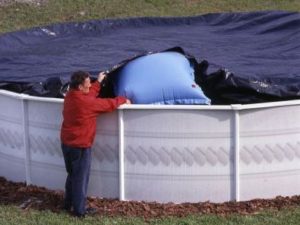Home / Winterize & Close Your Pool

Salt Water Pools: Fact and Fiction
November 20, 2018Swim Spa 101: Are Swim Spas Worth It?
April 22, 2019

It’s that time of year: when you need to prepare your pool for the snowy season. But what do you need to winterize your pool during the cold months? What does it mean to winterize your pool? Parrot Bay Pools has what you need to keep your inground swimming pool safe and secure all season long!
How to Winterize Your Pool
Closing your swimming pool for the winter season is a crucial step in maintaining its longevity and ensuring it’s ready for summer fun when the warmer months return. Properly winterizing your pool helps protect it from freezing temperatures, debris, and algae growth, ultimately saving you time and money on maintenance and repairs. In this comprehensive guide, we will walk you through the steps to close your swimming pool for winter effectively.
5 Tips For Properly Closing Your Swimming Pool:
- Adjust your pH level to the correct level for your type of pool.
- Adjust your calcium and alkalinity to required levels.
- Clean the pool. Remove all of the debris and brush the walls.
- Add your winterizing chemicals including algaecide.
- Adjust water levels and winterize plumbing lines based on the manufacturer’s instructions and install your cover.
1. Clean and Balance the Water
Before you begin the winterizing process, it’s essential to ensure your pool water is clean and balanced. Follow these steps to winterize your pool:
- Test the water chemistry using a pool water testing kit. Adjust the pH level to the recommended range of 7.2 to 7.6 and the alkalinity and calcium hardness levels as needed.
- Shock the pool with a suitable winterizing shock treatment to kill any remaining bacteria or algae.
- Add a winter algaecide to prevent algae growth during the winter months.
- Use a pool brush and vacuum to clean the pool walls and floor, removing any debris.
- Skim the pool’s surface to remove leaves, insects, and other debris.
2. Lower the Water Level
To protect your pool from freezing and potential damage, you’ll need to lower the water level below the skimmer and return lines. Follow these steps:
- Use a submersible pump or the pool’s filtration system to lower the water level to the appropriate height, typically below the skimmer and return lines.
- Drain the pool water to a level that allows for expansion and prevents freezing in the skimmer and plumbing lines.
3. Winterize the Pool Equipment
Properly winterizing your pool equipment is essential to prevent damage from freezing temperatures. Here’s what to do:
- Turn off the pool pump and filter system.
- Remove any plugs or drain caps from the filter, pump, and other equipment to allow water to drain out completely.
- Disconnect and drain the pool pump, filter, and any other accessories like heaters, chlorinators, and salt generators.
- Store the removed equipment in a dry, cool place, preferably indoors, to prevent damage from freezing and UV exposure.
4. Protect the Plumbing Lines
To prevent damage to your plumbing lines caused by freezing water, follow these steps:
- Blow out the plumbing lines using a pool air compressor or a shop vacuum. This will remove any remaining water from the pipes.
- Plug the skimmer and return lines with expansion plugs or gizmos designed for winterizing.
- Add pool antifreeze to the lines to provide extra protection against freezing.
5. Cover the Pool
A high-quality pool cover is crucial to keeping debris out and preventing algae growth during the winter. Follow these steps:
- Select a winter pool cover that fits your pool’s dimensions and type. There are various options, including solid, mesh, and safety covers.
- Place water bags or aqua blocks around the pool’s perimeter to hold the cover securely in place.
- Stretch the cover over the pool and secure it tightly using the provided hardware.
- Ensure the cover is taut to prevent debris buildup and water pooling.
6. Monitor and Maintain
Throughout the winter months, it’s essential to periodically check your pool’s condition:
- Remove any accumulated snow or debris from the cover to prevent it from sagging into the water.
- Occasionally check the water level to ensure it remains below the skimmer and return lines.
- Inspect the pool cover for any damage and repair it if necessary.
Why Winterize Your Pool
Properly closing your swimming pool for the winter is a crucial step in maintaining its longevity and preventing costly damage. By following these steps and taking the time to prepare your pool, you’ll ensure it’s ready for enjoyment when the warm weather returns. Winterizing your pool may seem like a chore, but it’s an investment in the longevity of your pool and a hassle-free swimming season ahead.
We Have What You Need to Winterize Your Pool
Prepackaged winterizing kits available for all pool types and sizes

Premium Kit

Basic Kit

Pristine Blue Kit

Small Above Ground Kit

Affordable Winterand Safety Covers

Air Pillows and Water Bags



